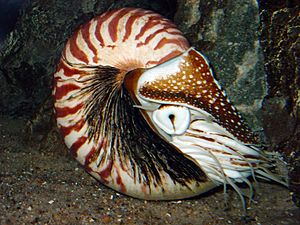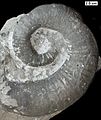Nautiloid facts for kids
Quick facts for kids Nautiloids |
|
|---|---|
 |
|
| Nautilus pompilius | |
| Scientific classification |
|
| Kingdom: | Animalia |
| Phylum: | Mollusca |
| Class: | Cephalopoda |
| Subclass: | Nautiloidea Agassiz, 1847 |
| Orders | |
|
Palcephalopoda
Neocephalopoda (in part)
|
|
Nautiloids are a fascinating group of sea creatures called cephalopods. They are part of the larger mollusc family, which also includes snails and clams. Nautiloids first appeared a very long time ago, in the late Cambrian period, about 495 million years ago! Today, only one type of nautiloid, the Nautilus, is still alive.
These ancient animals were very successful during the early Palaeozoic era. They were some of the top predators in the ocean. Over time, they developed many different shapes and forms for their shells. Scientists have found about 2,500 different kinds of fossil nautiloids, but only a few species are still around today.
What are Nautiloids?
Nautiloids belong to a special group of animals called cephalopods. This group also includes other amazing sea creatures like ammonoids (which are now extinct), Belemnites (also extinct), and modern animals like octopuses and squid. All cephalopods are advanced types of molluscs.
For a long time, scientists have divided cephalopods into three main groups: nautiloids, ammonoids, and coleoids (like octopuses and squids). This article focuses on nautiloids in this broad sense.
Scientists believe that nautiloids are an ancient group that gave rise to both ammonoids and coleoids. This means that ammonoids, octopuses, and squids probably all evolved from earlier nautiloid ancestors. For example, ammonoids and coleoids likely came from a type of nautiloid called bactritids, which themselves came from straight-shelled nautiloids.
Ammonoids are extinct relatives of nautiloids. They evolved about 400 million years ago during the Devonian period. This group includes the well-known ammonites and goniatites, which are often found as fossils.
Images for kids
-
A cross-section of a Nautilus pompilius shell. You can see the large chamber where the animal lives, and smaller chambers called camerae.
-
A fossil nautiloid called Trilacinoceras from the Ordovician period in China.
-
A fossil orthoconic nautiloid from the Ordovician period in Kentucky. This is an internal mold showing the siphuncle (a tube that runs through the chambers) and half-filled chambers.
See also
 In Spanish: Nautiloides para niños
In Spanish: Nautiloides para niños









